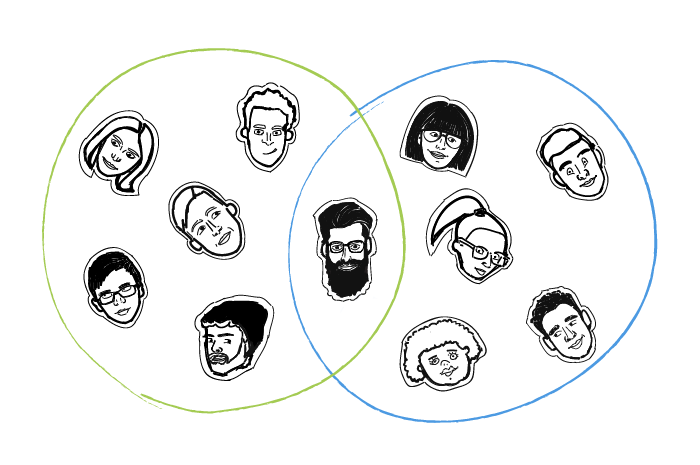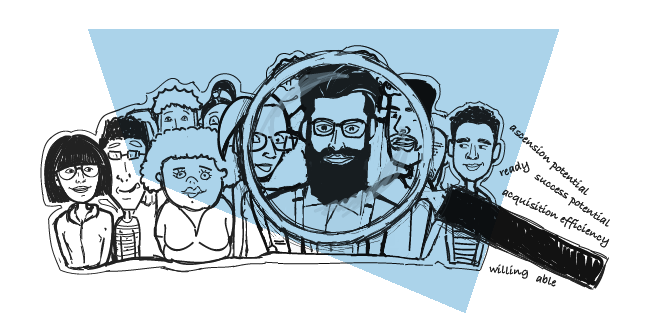We treat ICP (ideal customer profile) seriously at Woodpecker. We constantly work on the profile and try to keep it updated. That’s not an easy task, because the profile evolves as the company grows and the business situation changes. Our Customer Success Team runs regular meetings concerning ICP. On one of those meetings, we realized that the “ideal” may actually be a set of various traits, depending on the point of view. See what we’ve figured out in terms of defining our ideal customer profile.
Lincoln Murphy’s ICP Framework
We’re developing our ICP on the basis of the framework proposed by Lincoln Murphy. If you haven’t read that yet, that’s the moment to do that. Here’s the link to Lincoln’s ICP framework.
I won’t be able to analyze ICP better than Lincoln. That’s for sure. But I wanted to share with you how the theory gets verified in practice on our own example.
Lincoln’s ICP includes 7 baseline characteristics that a B2B company should consider while trying to define their ideal customer.
What are the ideal customer criteria?
An ideal customer should:
- be ready to solve a problem they have
- be willing to solve the problem
- be able to solve the problem
- have success potential
- be characterized by acquisition efficiency
- have ascension potential
- have customer-driven growth potential
Our reverse engineering method
In an attempt to verify our customer profile, some time ago we decided to take a look at our first 100 customers and try to choose 10 that are the best fit for the ideal customer profile we had previously assumed.
There were 5 meeting members: yours truly (marketing), Wojtek and Vovik (sales), Greg (support), Matt (CEO – product, and general bigger picture perspective). Each of us was supposed to take a look at the current customers and choose the top 10 for the ideal customer title.
And that was the moment when we realized: we’re not really sure about the criteria of the “ideal contest”. Shouldn’t we specify some common criteria first? We felt confused.
Greg, the coordinator of the ICP activities at Woodpecker and the leader of the meeting, explained that his idea was not to set the common criteria. On purpose. It was about verifying our definitions of “ideal”, and then checking which companies match the most of the “ideal” top tens.

“Ideal” may have various meanings
As it turned out in practice, the characteristics of the ideal customer may bear a different level of importance for various team members.
Marketing point of view
From the marketing point of view, the ideal customer should not only feel the value from the product but should be eager to spread the word about the solution. They should be open to putting their logo design on our website. What’s more, their brand and website should be impressive: we want some strong social proof that awesome companies use our tool. When a new website visitor checks out our current customers, they should be impressed.
Even better if the ideal customer is friendly and open to marketing cooperation. At the point when we will need a video testimonial, they should be dying to star in it. Ideally, they should be from the US or Western Europe, because that’s where we want more customers from – again, adequate social proof.
I’d say the ascension potential and the customer-driven growth potential from Lincoln’s framework is of great importance from the marketing perspective.
Sales point of view
From the sales point of view, the ideal customer should be eager to buy the product – so the reps don’t have to spend weeks closing the deal. They should like all the features we already have and they shouldn’t have any sales objections.
They should have the budget for more than one user account, ideally, they should be willing to buy a subscription for their whole sales team, and pay for a year in advance.
In the light of Lincoln’s framework, the characteristics of acquisition efficiency and being ready, willing and able to solve their problem seem to play the major part for the sales team.
Support & product point of view
From the support point of view, the ideal customer should be tech-savvy or have a person on their team that will be able to handle technical issues. They should know what they are doing when sending emails, understand the mechanisms behind email delivery and speak using some technical terms.
They should be friendly and patient. They should be open to receiving advice and willing to learn. Ideally, they should come from the same or a similar time zone, so the requests from them don’t come in the middle of the night.
From the product point of view, the ideal customer should be willing to offer feedback. They should not require a whole lot of new features to be added to the solution. Instead, they should be fully satisfied with the features we’ve already implemented. They should see our product as a piece perfectly fitting their sales process puzzle.
For the support and product teams, the success potential is a very important trait of the ideal customer.
So what’s the most important?
All of those characteristics are important. But finding a customer that perfectly fits into all of them is a real challenge.
So we thought, maybe some of them are more important than others? Maybe in the “ideal” contest, we should give priority to those customers who meet the most important criterium.
And when you really think about it, one of the 7 characteristics seems essential to kind of build up all the others.
It’s No 4 – success potential.
If a company achieve their desired outcome thanks to your solution and they feel they succeed:
- they will be eager to spread the word about your product;
- they will be open to putting their logo on your website and star in your testimonial video, because they will be able to honestly say that they are reaching their goals with your product;
- they will have a great website because their success will generate revenue which they will be able to invest in growth and improvement;
- they will keep using your product as long as they can see effects;
- they will need to go for additional subscriptions, as they grow;
- they will be able to pay for a year in advance;
- they will offer you feedback;
- they will organize their processes around your solution because it will bring them value.
It’s especially important to realize that in the SaaS model
A company that has a great brand, website and lots of clients may look great in your customer base, but if they don’t feel that your solution brings them additional value, they won’t stay in the customer base for a long time.
A company that has a big budget and is ready to purchase your solution, will probably purchase it if you sell it well. But if they don’t see the results, they won’t add any new user accounts or prolong their subscription.
A company that loves Woodpecker‘s UI and all its features, but sells to a target group that is not responsive to email, will not succeed with Woodpecker. And hence, they won’t stay our customer for a long time, despite all the love they have for our product and support team.
What’s in it for you
If you don’t trust me on this one, trust Lincoln Murphy. Check his post about the importance of success potential.
What I love about Lincoln’s articles is that he draws your attention to those perfectly logical B2B mechanisms, which we often seem to miss on a daily basis.
You get a demo with a potentially interested prospect and you jump around them to sell them your product, instead of checking what they do and if they actually have a chance to succeed with your solution. You see a trial user checking out for a premium account, and you jump for joy instead of checking how you can help them actually get some real value from your solution. I bet you know what I’m talking about here.
And you forget about those simple and 100% logical rules: if they don’t get value, they won’t stay for a long time. If you put a lot of time and energy into acquiring a new customer, and they churn after a month of premium subscription, all the time and energy you spent for them to become a customer won’t pay off. It’s that simple.
And here comes the point…
Please make sure you take it away from reading all this: focus on your customer success. Focus on their success potential first.
How is that connected to cold email?
If you target your outbound email campaigns at the right prospects from the very beginning, you’ll get better results. And not only in terms of positive reply rates but in terms of actually getting new customers from outbound.
So before you start building your prospect base and writing the copy of your emails, stop for a moment and ask yourself those two crucial questions:
- What is the chance they will succeed with your solution? (in terms of their business goals and their target market)
- Do I have the resources necessary to help them achieve success in their field? (in terms of my current set of features and support capabilities)
If the answer is a double yes, go for it. If one of them is a no, find another target group and start there.
***
See also:
What’s the First Step to Building a Good Prospect Base? >>
Who Are Really My Prospects? – Our Way for Persona Development >>
READ ALSO

SaaS customer interviews: How to carry them out & what you can learn
When was the last time you actually talked to your customers? I don't mean a sales call or a demo. I mean actually talking about their business, your business, and how the two virtually affect each other. Our Outbound Sales team has just finalized their 3.5-month long project of customer interviews. Last week, they presented the results to the whole Woodpecker team. That inspired me to write about how you can do it as well at your SaaS company. So here it goes! See how to carry out customer interviews and what you can learn from talking to your clients.

Do You Know Your Prospects at All?
Do you know who your prospects are as people? What do they like? What do they care about? What are the things that they can’t stand? What are their personal and business goals? Here’s how we've found specific answers to all those questions for our business, and why finding those answers is so important for the success of your company.

How We Actually Rework Our Ideal Customer Profile
At the beginning of 2016, I wrote about the Ideal Customer Profile (ICP) framework that we adopted at Woodpecker and about the way we worked on our marketing personas. At that point, we had around 100 B2B customers. Our customer base has grown to 1000 since then. And it has obviously changed a bit, too. Here's about how we actually measure the changes in our customer base in order to constantly rework our ideal customer profile as our company grows, and why it's important to keep the ICP up to date in general.

